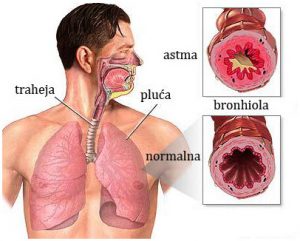Asthma
Asthma is a chronic non-communicable lung disease characterized by the occasional appearance of inflammation and narrowing of the airways. Typical asthma symptoms are:
- A cough
- “Playing” in the lungs when breathing (vizing)
- Feeling of suffocation and shortness of breath
- Chest tightness
Asthma can occur in people of all ages, but most often begins in childhood.
What is the cause of asthma?
The cause of asthma has not yet been discovered, although a significant role of hereditary factors has been observed (more frequent occurrence of hypersensitivity diseases in close relatives, such as allergic rhinitis, eczema or asthma).
Why do asthma symptoms occur?
To understand asthma, you need to know how the airways work. The airways are tubular in shape, and starting from the trachea, through the bronchi and bronchioles, they branch to the smallest parts, the alveoli. The inside of the airways is lined with mucous membranes, and smooth muscles are placed around the airways, whose contraction and relaxation change the diameter of the airways. In people with asthma, the airways are overly sensitive to various factors. This hypersensitivity, or hyperreactivity, is characterized by swelling and increased secretion in the airways. Also, the smooth muscles around the airways contract (spasm), which further reduces the lumen of the airways and makes breathing difficult.
Are asthma symptoms always the same?
The severity of asthma symptoms can vary significantly. Sometimes, the symptoms are mild and go away even on their own, or with the use of minimal doses of medication. If the symptoms are more pronounced and last longer, we are talking about an acute asthma attack. If the symptoms are pronounced, last longer than 24 hours, and do not respond to the application of therapy, we are talking about an acute severe asthma attack (status asthmaticus). Acute severe asthma attack is the most severe form of asthma that sometimes threatens the patient’s life.
How is asthma diagnosed?
The diagnosis of asthma is made on the basis of anamnesis, clinical examination and lung function tests.
An important fact in the anamnesis (conversation with the patient) is the presence of asthma or allergic disorders (eczema, allergic rhinitis) in close relatives. The presence of asthma in the parents does not mean that the child will certainly have asthma, but heredity certainly has an impact on the tendency towards allergic reactions.
It is important to examine the frequency of asthma symptoms in relation to the season or other factors, the so-called. “Triggers” that can affect the onset of asthma symptoms.
Clinical examination includes examination with a stethoscope, during which attention is paid to the presence of whistling (whistling, playing in the lungs). The absence of whistling does not exclude the presence of asthma, because whistling is heard only during the worsening of asthma, while outside the attack, the respiratory noise is generally completely normal.
Spirometry is a diagnostic method during which the preservation of lung function is examined. By measuring the amount of air that is inhaled and exhaled, significant data on the condition of the lungs are obtained. Depending on which of the volume and capacity is reduced, it can be concluded whether it is a restrictive or obstructive disorder.
Testing for known inhalation and nutrient allergens (allergo-test) can be performed to identify the “triggers” of an asthma attack.
Asthma treatment
A cure for asthma has not yet been discovered. However, with the application of appropriate therapy, it is possible to control the manifestation of symptoms very successfully. Good asthma control aims to:
Prevention of chronic and problematic symptoms
Reducing the need to use medications to calm an acute asthma attack
Reducing the possibility of developing a more severe clinical picture (asthmatic status), which can have serious consequences for the patient.
Normal rhythm of rest and sleep, as well as performing daily activities
Drugs used in the treatment of asthma can be divided into two groups:
Medications to calm acute symptoms
These drugs enable fast and efficient relaxation of the muscles that surround the airways, which enables normal air flow in the airways. Inhaled beta-2 agonists are the drug of choice in the treatment of acute asthma symptoms. Every person with asthma must always have an inhaler (pump) on hand and apply the medicine immediately after the appearance of characteristic symptoms, in order to prevent further progression of symptoms.
Drugs to prevent the onset of acute symptoms
Inhaled corticosteroids are the drug of choice in the long-term treatment of asthma. Corticosteroids reduce inflammation and swelling of the mucous membranes of the airways, thus preventing the onset of acute asthma symptoms. Over the years, new corticosteroid drugs have been developed, which are minimally absorbed into the bloodstream, so the possibility of developing side effects is less.
Leukotriene inhibitors also aim to reduce the inflammatory response. These drugs are available in tablet form.
Long-acting beta agonists are generally added to inhaled corticosteroids, never used alone in the long-term treatment of asthma.
Anti-IgE antibodies neutralize a class of IgE antibodies that mediate hypersensitivity reactions. These drugs are usually administered 1-2 times a month, in the form of injections.
Asthma is a condition that is very common
Astma je stanje koje se veoma dobro može držati pod kontrolom. Redovni kontrolni pregledi su važan deo tretmana, kako bi se pratila uspešnost propisane terapije, i na vreme preduzele mere u slučaju pogoršanja simptoma.
Reference:
https://www.asthmaaustralia.org.au/
https://www.nhlbi.nih.gov/health/health-topics/topics/asthma/treatment
http://www.mayoclinic.org/diseases-conditions/asthma/basics/definition/con-20026992
